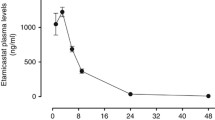Summary
The renal effects of manidipine hydrochloride were investigated in ten hospitalised patients with mild-to-moderate essential hypertension. After a one-week placebo period, manidipine was given for 1 week in a dose rising from 5 mg to 10 mg or 20 mg daily to normalise the mean blood pressure measured after 2 h.
Blood pressure had decreased from 171/101 to 147/86 mm Hg at the end of manidipine treatment. The pulse rate was unaltered. Renal vascular resistance decreased from 1.90 to 1.33 dyn · s · cm−5/1.48 m2 × 104, and renal blood flow and glomerular filtration rate increased from 522 to 662 ml · min−1 · 1.48 m−2 and from 81 to 93 ml · min−1 · 1.48 m−2, respectively, in spite of a fall in renal perfusion pressure. Manidipine reduced the filtration fraction from 0.260 to 0.243, suggesting a preferential reduction in efferent arteriolar resistance. The fractional excretion of sodium and potassium did not change. Manidipine did not produce any significant alteration in plasma renin activity or in the plasma aldosterone concentration.
The results indicate that manidipine has favourable renal effects and a concomitant hypotensive action in patients with mild-to-moderate essential hypertension.
Similar content being viewed by others
References
Hollenberg NK (1987) Vasodilators, antihypertensive therapy, and the kidney. Circulation 75 [Suppl V]: V39-V42
Bauer JH, Sunderrajan S, Reams G (1985) Effects of calcium entry blockers on renin-angiotensin-aldosterone system, renal function and hemodynamics, salt and water excretion and body fluid composition. Am J Cardiol 56: 62H-67H
Meguro K, Aizawa M, Sohda T, Kawamatsu Y, Nagaoka A (1985) New 1,4-dihydropyridine derivatives with potent and long-lasting hypotensive effect. Chem Pharm Bull (Tokyo) 33: 3787–3797
Nagaoka A, Shibouta M, Hamajo K (1989) Effect of a new dihydropyridine derivative, CV-4093 · 2HCl, on renal hemodynamics in spontaneously hypertensive rats. Jpn J Pharmacol 51: 25–35
Nagaoka A, Shibouta M (1989) Natriuretic action of manidipine hydrochloride, a new calcium channel blocker, in spontaneously hypertensive rats. Jpn J Pharmacol 51: 299–301
Suzuki S, Takahira T, Mori M (1990) Pharmacokinetic study of a Ca antagonist, manidipine hydrochloride, in patients with essential hypertension at a single dose of 20 mg (in Japanese). Rinshoiyaku 6: 1090–1095
Kumahara Y, Kaneko Y, Iimura O et al. (1989) Effect of manidipine, Ca antagonist, on circadian rhythm of blood pressure in patients with essential hypertension (in Japanese). Rinshoiyaku 5: 905–922
Aoki K, Kondo S, Mochizuki A, Yoshida T, Kato S, Kato K, Takikawa K (1978) Antihypertensive effect of cardiovascular Ca2+-antagonist in hypertensive patients in the absence and presence of beta-adrenergic blockade. Am Heart J 96: 216–226
Takabatake T, Ohta H, Yamamoto Y, Maekawa M, Arai S, Hattori N, Nomura G (1982) Antihypertensive effect of nicardipine hydrochloride in essential hypertension. Int J Clin Pharmacol Ther Toxicol 20: 346–352
Olivari MT, Bartorelli C, Polese A, Fiorentini C, Moruzzi P, Guazzi MO (1979) Treatment of hypertension with nifedipine, a calcium antagonistic agent. Circulation 59: 1056–1062
Pedrinelli R, Fouad FM, Tarazi RC, Bravo EL, Textor SC (1986) Nitrendipine, a calcium-entry blocker: renal and humoral effects in human arterial hypertension. Arch Intern Med 146: 62–65
Baba T, Ishizaki T, Murabayashi S, Aoyagi K, Tamasawa N, Takebe K (1987) Multiple oral doses of nicardipine, a calcium-entry blocker; effects on renal function, plasma renin activity, and aldosterone concentration in mild-to-moderate essential hypertension. Clin Pharmacol Ther 42: 232–239
Yokoyama S, Kaburagi T (1983) Clinical effects of intravenous nifedipine on renal function. J Cardiovasc Pharmacol 5: 67–71
Gómez DM (1951) Evaluation of renal resistance with specific reference to changes in essential hypertension. J Clin Invest 30: 1143–1155
Willassen Y, Ofstad J (1983) Intrarenal pressure and sodium excretion in hypertension of chronic glomerulonephritis in humans. Hypertension 5: 375–384
De Leeuw PW, Birkenhager WH (1983) The renal circulation in essential hypertension. J Hypertension 1: 321–331
Yokoyama S, Kaburagi T (1981) Effects of intravenous nicardipine hydrochloride (YC93), a calcium antagonist, on renal function. Jpn J Nephrol 23: 1143–1151
Chaignon M, Bellet M, Lucsko M, Rapound C, Guedon J (1986) Acute and chronic effects of a new calcium inhibitor, nicardipine, on renal hemodynamics in hypertension. J Cardiovasc Pharmacol 8: 892–897
Lupinacci L, Palomino C, Greenberg A, Puschett JB (1988) Chronic effects of nitrendipine on renal hemodynamics and tubular transport. Clin Pharmacol Ther 43: 6–15
Allison N, Dunn J, Alexander F et al. (1985) Effect of nilvadipine on renal function in normal man (abstract). Fed Proc 44: 1638
Takabatake T, Ohta H, Yamamoto Y et al. (1989) Renal function during antihypertensive therapy with a calcium antagonist, nilvadipine (in Japanese). Jpn Pharmacol Ther 17: 2155–2160
Jackson B, Johnston CI (1988) The contribution of systemic hypertension to progression of chronic renal failure in the rat remnant kidney; effect of treatment with an angiotensin converting enzyme inhibitor or a calcium inhibitor. J Hypertension 6: 495–502
Mimran A, Insua A, Ribstein J, Bringer J, Monnier L (1988) Comparative effect of captopril and nifedipine in normotensive patients with incipient diabetic nephropathy. Diabetes Care 11: 850–853
Anderson S, Rennke HG, Brenner BM (1986) Therapeutic advantage of converting enzyme inhibitors in arresting progressive renal disease associated with systemic hypertension in the rat. J Clin Invest 77: 1993–2000
Yamaguchi I, Ikezawa K, Takada T, Kiyomoto A (1974) Studies on new 1,5-benzothiazepine derivative (CRD-401). VI. Effects on renal blood flow and renal function. Jpn J Pharmacol 24: 511–522
Shibouta Y, Kitayoshi T, Kitoh G, Nishikawa K (1988) Calcium channel blocking action of franidipine hydrochloride (CV-4093 · 2HCl) in vitro and in vivo. Jpn J Pharmcol 48: 463–472
Leonetti G, Cuspidi C, Sampieri L et al. (1982) Comparison of cardiovascular, renal and humoral effects of acute administration of two calcium channel blockers in normotensive and hypertensive subjects. J Cardiovasc Pharmacol 4: S319-S324
Author information
Authors and Affiliations
Rights and permissions
About this article
Cite this article
Takabatake, T., Ohta, H., Sasaki, T. et al. Renal effects of manidipine hydrochloride. Eur J Clin Pharmacol 45, 321–325 (1993). https://doi.org/10.1007/BF00265948
Received:
Accepted:
Issue Date:
DOI: https://doi.org/10.1007/BF00265948




